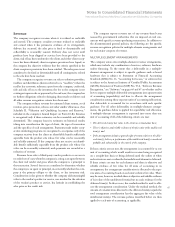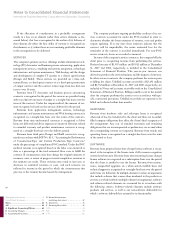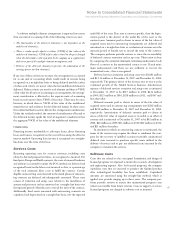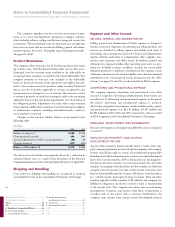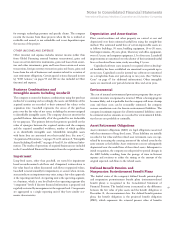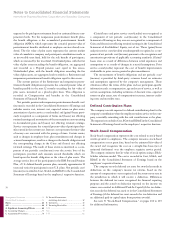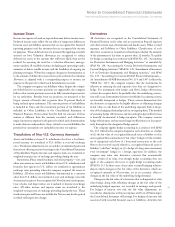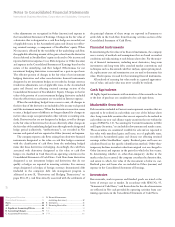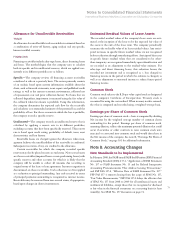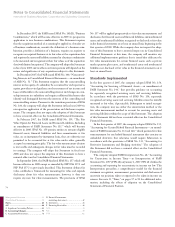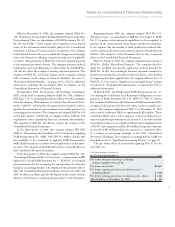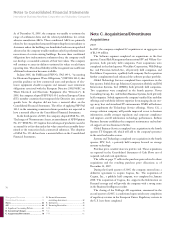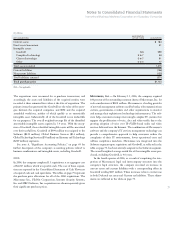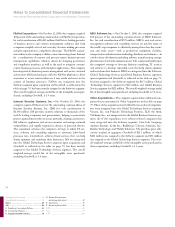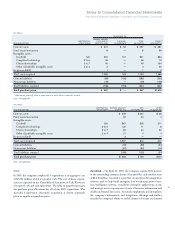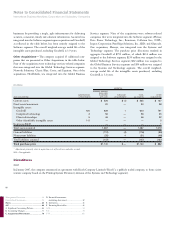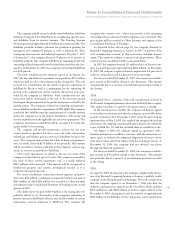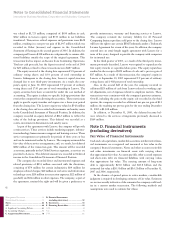IBM 2007 Annual Report Download - page 74
Download and view the complete annual report
Please find page 74 of the 2007 IBM annual report below. You can navigate through the pages in the report by either clicking on the pages listed below, or by using the keyword search tool below to find specific information within the annual report.
72
Notes to Consolidated Financial Statements
International Business Machines Corporation and Subsidiary Companies
Management Discussion ..................................14
Consolidated Statements ..................................58
Notes ........................................................... 64
A-F ............................................................. 64
A. Significant Accounting Policies ............ 64
B. Accounting Changes ............................. 73
C. Acquisitions/Divestitures ............................76
D. Financial Instruments
(excluding derivatives).................................82
E. Inventories ...................................................83
F. Financing Receivables .................................83
G-M ..................................................................84
N-S ...................................................................94
T-W ................................................................102
value adjustments are recognized in Other (income) and expense in
the Consolidated Statement of Earnings. Changes in the fair value of
a derivative that is designated as a cash flow hedge are recorded, net
of applicable taxes, in the Accumulated gains and (losses) not affect-
ing retained earnings, a component of Stockholders’ equity. When
Net income is affected by the variability of the underlying cash flow,
the applicable offsetting amount of the gain or loss from the derivative
that is deferred in Stockholders’ equity is released to Net income and
reported in Interest expense, Cost, SG&A expense or Other (income)
and expense in the Consolidated Statement of Earnings based on the
nature of the underlying cash flow hedged. Effectiveness for net
investment hedging derivatives is measured on a spot-to-spot basis.
The effective portion of changes in the fair value of net investment
hedging derivatives and other non-derivative financial instruments
designated as net investment hedges are recorded as foreign currency
translation adjustments, net of applicable taxes, in the Accumulated
gains and (losses) not affecting retained earnings section of the
Consolidated Statement of Stockholders’ Equity. Changes in the fair
value of the portion of a net investment hedging derivative excluded
from the effectiveness assessment are recorded in Interest expense.
When the underlying hedged item ceases to exist, all changes in
the fair value of the derivative are included in Net income each period
until the instrument matures. When the derivative transaction ceases
to exist, a hedged asset or liability is no longer adjusted for changes in
its fair value except as required under other relevant accounting stan-
dards. Derivatives that are not designated as hedges, as well as changes
in the fair value of derivatives that do not effectively offset changes in
the fair value of the underlying hedged item throughout the designated
hedge period (collectively, “ineffectiveness”), are recorded in Net
income each period and are reported in Other (income) and expense.
The company reports cash flows arising from derivative financial
instruments designated as fair value or cash flow hedges consistent
with the classification of cash flows from the underlying hedged
items that these derivatives are hedging. Accordingly, the cash flows
associated with derivatives designated as fair value or cash flow
hedges are classified in Cash flows from operating activities in the
Consolidated Statement of Cash Flows. Cash flows from derivatives
designated as net investment hedges and derivatives that do not
qualify as hedges are reported in investing activities. For currency
swaps designated as hedges of foreign currency denominated debt
(included in the company’s debt risk management program as
addressed in note K, “Derivatives and Hedging Transactions,” on
pages 88 to 91), cash flows directly associated with the settlement of
the principal element of these swaps are reported in Payments to
settle debt in the Cash flow from financing activities section of the
Consolidated Statement of Cash Flows.
Financial Instruments
In determining the fair value of its financial instruments, the company
uses a variety of methods and assumptions that are based on market
conditions and risks existing at each balance sheet date. For the major-
ity of financial instruments, including most derivatives, long-term
investments and long-term debt, standard market conventions and
techniques such as discounted cash flow analysis, option pricing mod-
els, replacement cost and termination cost are used to determine fair
value. Dealer quotes are used for the remaining financial instruments.
All methods of assessing fair value result in a general approxima-
tion of value, and such value may never actually be realized.
Cash Equivalents
All highly liquid investments with maturities of three months or less
at the date of purchase are considered to be cash equivalents.
Marketable Securities
Debt securities included in Current assets represent securities that are
expected to be realized in cash within one year of the balance sheet
date. Long-term debt securities that are not expected to be realized in
cash within one year and alliance equity securities that are within the
scope of SFAS No. 115, “Accounting for Certain Investments in Debt
and Equity Securities,” are included in Investments and sundry assets.
Those securities are considered available for sale and are reported at
fair value with unrealized gains and losses, net of applicable taxes,
recorded in Accumulated gains and (losses) not affecting retained
earnings within Stockholders’ equity. Realized gains and losses are
calculated based on the specific identification method. Other-than-
temporary declines in market value from original cost are charged to
Other (income) and expense in the period in which the loss occurs.
In determining whether an other-than-temporary decline in the
market value has occurred, the company considers the duration that,
and extent to which, fair value of the investment is below its cost.
Realized gains and losses also are included in Other (income) and
expense in the Consolidated Statement of Earnings.
Inventories
Raw materials, work in process and finished goods are stated at the
lower of average cost or market. In accordance with SFAS No. 95,
“Statement of Cash Flows,” cash flows related to the sale of inventories
are reflected in Net cash provided by operating activities from con-
tinuing operations in the Consolidated Statement of Cash Flows.





